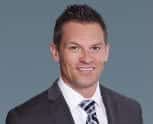Tommy John Surgery in the Throwing Athlete
- What Are the Risk Factors for Tommy John Surgery?
- What Are the Symptoms of a UCL Injury?
- Can a UCL Injury Be Treated Non-Surgically?
- What Is the Surgical Treatment for a UCL Injury?
- What Is the Recovery Like After Tommy John Surgery?
Ulnar collateral ligament (UCL) reconstruction is performed on athletes, most commonly baseball pitchers, when they tear this important stabilizing ligament in their throwing elbow and the nonsurgical treatment options have failed.
Named Tommy John surgery outside of the medical field, this procedure was first performed in 1974 by Dr. Frank Jobe on Major League Baseball pitcher Tommy John. At the time of the original Tommy John surgery, Dr. Jobe put his chances of recovering from the ligament injury at one in 100. Today, literature says that number is closer to the 90 percent mark thanks to advances in technology and modern medicine.
“When the ulnar collateral ligament sustains a tear, the throwing athlete often complains of pain on the inside, or medial, part of the elbow as well as a loss of velocity and control on their pitch,” says Randy S. Schwartzberg, M.D., a board-certified sports medicine specialist at Orlando Orthopaedic Center. “If non-surgical treatment fails for the UCL tear, the surgical treatment involves replacing the ligament with a tendon graft.”
To ensure that the UCL can return to functioning as the stabilizing structure of the elbow, a complete replacement is necessary. Although it can heal, it often heals in a lengthened position, resulting in a loose condition that can hinder the throwing athlete from ever returning to the type of play they were accustomed to prior to ligament injury.
“Damage to the ulnar collateral ligament can occur suddenly or gradually after continued stress on the throwing athlete’s elbow,” says Dr. Schwartzberg. Before discussing Tommy John surgery in-depth, the following is background on ulnar collateral ligament tears.
What Are the Risk Factors for Tommy John Surgery?
Risk factors for tearing the UCL involve excessive use or repeated stress being placed on the ligament. In day-to-day activities, it’s very rare to injure the ulnar collateral ligament ligament. Most injuries occur in baseball because of the intense overhead motion and force used when winding up and releasing hundreds of pitches. Ultimately, the UCL becomes compromised and tears.
“Other risk factors may include contact sports where one may fall on an outstretched hand, ultimately dislocating their elbow,” says Bradd G. Burkhart, M.D., a board-certified sports medicine specialist and colleague of Dr. Schwartzberg’s at Orlando Orthopaedic Center.
“We also see UCL ligament tears in other overhead athletes, such as volleyball and tennis players as well. Throwing mechanics and form also contribute to risk factors of the injury.”
What Are the Symptoms of a UCL Injury?
Symptoms of a UCL injury that may ultimately lead to Tommy John surgery and a complete ligament reconstruction include pain on the inner side of the elbow. Many athletes also note a “pop” or “tearing” sensation at the site of the injury, according to Dr. Schwartzberg.
“Then swelling and bruising may be noticeable after roughly 24 hours post injury,” he says. “Athletes will also notice newfound elbow stiffness and they may feel a slight numbness or tingling in the small and ring fingers of the injured arm.”
Can a UCL Injury Be Treated Non-Surgically?
A mild tear to the ulnar collateral ligament may heal on its own. Non-surgical treatment for the ligament tear consists of medications, ice and rest to relieve pain and swelling. Functional rehabilitation supervised by a skilled sports medicine athletic trainer or physical therapist is the most important component of non-surgical management.
What Is the Surgical Treatment for a UCL Injury?
Tommy John surgery is recommended to those that have sustained an acute rupture or partial tear of the UCL ligament and where non-surgical treatment has failed to improve the injury. The procedure is performed under general anesthesia by a trained orthopaedic surgeon.
Ligament reconstruction begins with an incision on the inner part of the elbow where the damaged ligament is removed. From there, holes are drilled to accommodate the new tendon grafts, often taken from the palmaris longus tendon found in the forearm or the gracilis tendon in the leg, according to Dr. Schwartzberg.
These holes are drilled in the ulna and humerus bones of the elbow precisely where the ulnar collateral ligament attaches. “Then we place the new tendon into the sockets created in the ulna and humerus. The graft is then secured with fixation devices to allow an accelerated rehabilitation approach,” says Dr. Schwartzberg. “After one week in a splint, the throwing athlete is placed into a hinged elbow brace with no range of motion restrictions. Rehabilitation commences with progressive functional activities leading up to an interval throwing program at the four month postoperative mark.”
Potential complications of the surgery include infection, elbow range of motion loss and ulnar nerve issues. However, the rate of these complications is very small following the procedure.
What Is the Recovery Like After Tommy John Surgery?
“Typically we see a return to the sport of choice following surgery within 6-9 months,” says Dr. Burkhart. “Rehab can be carried out at home, but at Orlando Orthopaedic Center we recommend patients see our physical therapists to help guide their road to recovery.”
Because the graft is very strong and fixation is so secure, early range of motion and rehabilitation is safe. Physical therapy is necessary to regain strength and range of motion in the elbow following Tommy John surgery and may begin following the first several weeks of recovery.
“Although range of motion and strength about the elbow returns within a couple of months of the surgery, the throwing athlete still has a large amount of work to ready the elbow for throwing,” says Dr. Schwartzberg. “Emphasis on the entire kinetic chain during rehabilitation is critical. The throwing motion begins with the legs, involves the trunk and then the shoulder, elbow and wrist. Core strengthening is very important and a hard working and patient athlete can end up becoming a stronger, healthier throwing athlete.”
Most patients make a complete recovery and return to normal activities with little to no change in their routine once fully healed.

